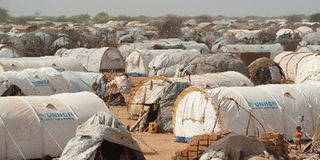Hopelessness and uncertainty a way of life in Kenya's Dadaab refugee camp

Dadaab refugee camp. The uncertainty imposed on Dadaab by government is bad for aid workers as well as refugees. Refugees say they receive less food since announcement of the camp closure two years ago and aid agencies are not able to plan for the long-term. PHOTO | PHIL MOORE | AFP
What you need to know:
- It was May 6, 2016 when everything changed for Fartun, the govt announced closure of Dadaab refugee camp.
- Without providing proof, the government also alleged that Dadaab was a staging ground for terror attacks in Kenya.
- So Fartun joined an estimated 75,000 since the repatriations began and made her reluctant return to Somalia in June 2016.
- But only 50km inside Somalia the convoy, bound Baidoa, was ambushed by hooded, armed men.
DADAAB,
Between the rape she suffered during a traumatic return to Somalia, the constant hunger, and the uncertainty of her future in Kenya's Dadaab camp, Fartun has almost forgotten what hope feels like.
Two years ago Kenya's government said it would close what was at the time the world's largest refugee settlement.
It has failed to do so, but the threat looms over residents, adding a new layer of precariousness to an already tough existence.
"Before, life at the camp was good... but it's not the same," said Fartun, a 37-year-old mother of 11.
REPATRIATION
She went back to Somalia as part of a repatriation programme, criticised as coercive and premature by human rights groups, but returned to Dadaab when her homecoming went terribly wrong.
It was May 6, 2016 when everything changed for Fartun.
Nairobi announced the closing of Dadaab — which had nearly 350,000 residents — and, deeming war-torn and famine-prone Somalia to be safe enough, said the refugees would be sent home.
Without providing proof, the government also alleged that Dadaab was a staging ground for terror attacks in Kenya by Al-Qaeda affiliate Shabaab.
"The Kenyan government had said in the past that it wanted to close the camp, but this time was different: they looked really serious," Fartun said.
Ignoring the legal and logistical concerns of international aid agencies, a deadline of November 2016 was initially set, and then postponed to May 2017, as a two-year-old programme of so-called "voluntary repatriations" was accelerated.
For many there seemed little choice.
"In the camp, it was said that if we did not leave, we would be beaten," said Fartun. "Maybe it was rumours, I don't know, but that was the atmosphere in the camp."
ORDEAL
So Fartun joined an estimated 75,000 since the repatriations began and made her reluctant return to Somalia in June 2016.
She took the $400 resettlement allowance and boarded a minivan with her family, bound for the border.
But only 50 kilometres inside Somalia the convoy, bound for the south-western town of Baidoa, was ambushed by hooded, armed men and Fartun and her family were taken captive.
Fartun was raped multiple times before being released. Her eldest son, then 12-year-old Abdirizak, was press-ganged into the militia.
"They wanted to recruit me," said the boy. A wide scar runs the length of Abdirizak's forearm, a punishment, he said, from the gunmen.
"They gave me a rifle and ordered me to shoot, but I refused, so they did this to my arm."
Mother and son were reunited a few months after their ordeal, when Abdirizak managed to escape the militia, and soon returned to Dadaab together.
CLOSURE
A reprieve was granted in February 2017 when Kenya's courts outlawed the closure of Dadaab.
Harun Kamau, the top government official in Dadaab, said just 2,000 Somalis had returned to Dadaab after participating in the repatriation programme.
But several aid agencies said that figure was a huge underestimate.
The return has been difficult for Fartun, who found much has changed for the worse.
"Since we came back, there is less food, and we live at my brother-in-law's because I have no house," she said.
The population has reduced too, now officially numbering 235,000.
Kenyan authorities are making it harder for Somalis to claim refugee status, by making them submit individual applications, rather than automatically granting them asylum.
Those who remain are receiving a third less food than before, a result of funding shortfalls, says the UN's World Food Programme.
"Dadaab has been there for 27 years. Donors feel a bit tired compared to other crises like the Syrian refugees, or the Rohingyas," said one UN official in Dadaab.
The uncertainty imposed on Dadaab by government is bad for aid workers, as well as refugees.
"The first thing the donors tell us is: Why have long-term programmes when the camp will soon be closed?" said Caleb Odhiambo, Save the Children's director in Dadaab.
Aid agencies are disappointed that the government has failed to publicly acknowledge that the swift closing of Dadaab is impossible, and while they welcome a proposed law to help integrate refugees into Kenyan society, they bemoan its slow passing.
Meanwhile, the experience of Fartun and others who endured failed repatriation, means fewer than ever are willing to leave.
"Even if the camp closes today, I'd rather stay somewhere here than go back to Somalia again, she said."





